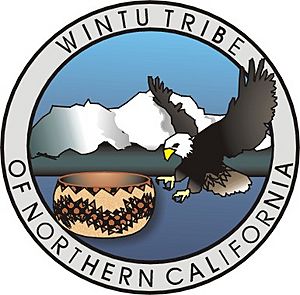Wintu facts for kids

Seal
|
|
| Total population | |
|---|---|
| 2,500 (three major groups) | |
| Regions with significant populations | |
| Languages | |
| English, formerly Wintu | |
| Religion | |
| Christianity, Native religion | |
| Related ethnic groups | |
| Wintun (Nomlaki and Patwin), Yokuts |
The Wintu (also Northern Wintun) are Native Americans who live in what is now Northern California. They are part of a loose association of peoples known collectively as the Wintun (or Wintuan). Others are the Nomlaki and the Patwin. The Wintu language is part of the Penutian language family.
Historically, the Wintu lived primarily on the western side of the northern part of the Sacramento Valley, from the Sacramento River to the Coast Range. The range of the Wintu also included the southern portions of the Upper Sacramento River (south of the Salt Creek drainage), the southern portion of the McCloud River, and the upper Trinity River. They also lived in the vicinity of present-day Chico, on the west side of the river extending to the Coast Ranges. Today most Wintus live on reservations and rancherias in Colusa, Glenn, Yolo, Mendocino, and Shasta counties.
History
The first recorded encounter between Wintu and Euro-Americans dates from the 1826 expedition of Jedediah Smith, followed by an 1827 expedition led by Peter Skene Ogden. Between 1830 and 1833, many Wintu died from a malaria epidemic that killed an estimated 75% of the indigenous population in the upper and central Sacramento Valley.
In the following years, the weakened Wintu fell victim to competition for resources by incoming European-American settlers. The settlers' sheep and cattle herds destroyed the Wintu food supply while gold miners' processing activities caused pollution of rivers. The Wintu were also forced to work as laborers in gold mining operations. In 1846, John C. Frémont and Kit Carson accompanied by local white settlers killed 175 Wintu and Yana by force of arms
Settlers tried to take over Wintu land and relocate them west of Clear Creek. At a "friendship feast" in 1850, settlers served poisoned food to local natives, from which 100 Nomsuu and 45 Wenemem Wintu died. More deaths of Wintu and destruction of their land followed in 1851 and 1852, in incidents such as the Bridge Gulch Massacre.
Culture
The Wintu language is one of the Wintuan languages; it is also called Wintu.
The religious stories and legends of the Trinity River Wintu were told by Grant Towendolly to Marcelle Masson, who published them in A Bag of Bones (1966).
Population
Scholars have disagreed about the historic population of the tribes before European-American contact. Alfred L. Kroeber estimated the combined 1770 population of the Wintu, Nomlaki, and Patwin as 12,000. Sherburne F. Cook initially put the population of the Wintu proper as 2,950, but later nearly doubled his estimate to 5,300. Frank R. LaPena estimated a total of 14,250 in his work of the 1970s.
Kroeber estimated the population of the Wintu, Nomlaki, and Patwin in 1910 as about 1,000. Today the population has recovered somewhat and there are about 2,500 Wintun, many of whom live on the Round Valley Reservation, and on the Colusa, Cortina, Grindstone Creek, Redding, and Rumsey rancherias.

